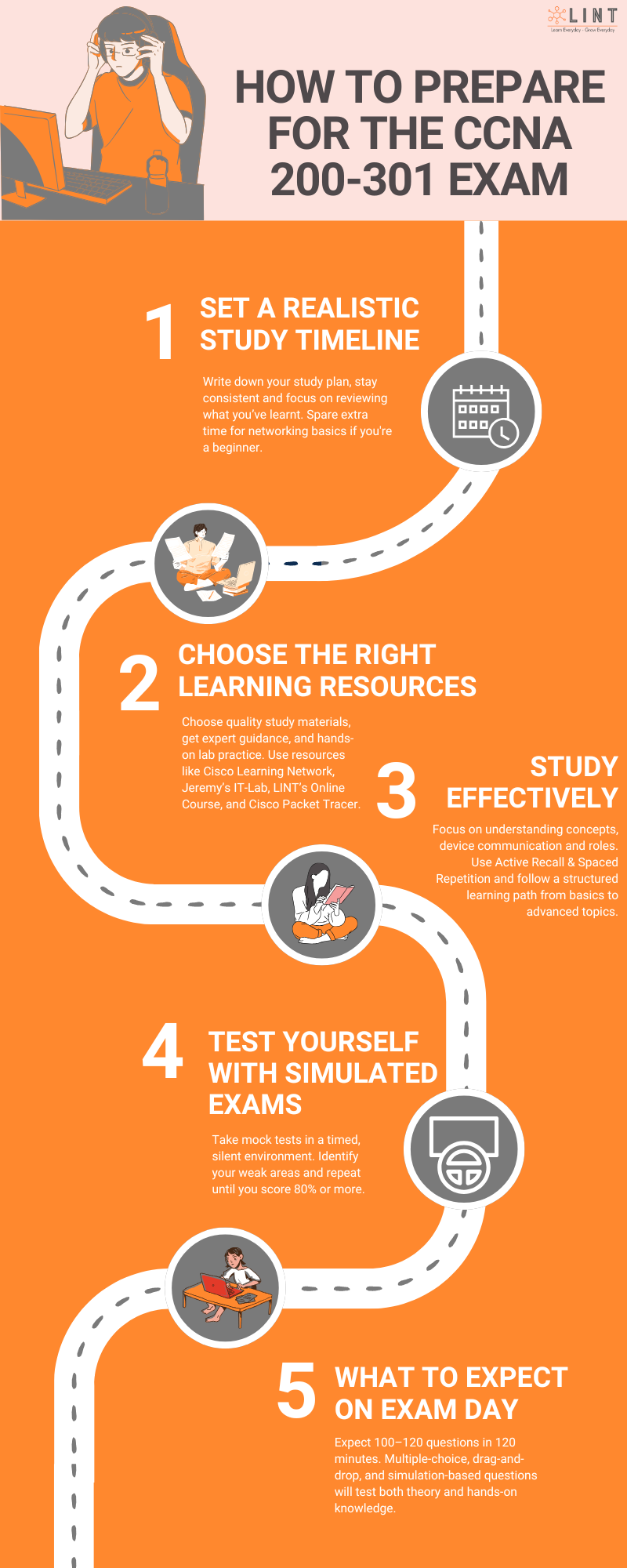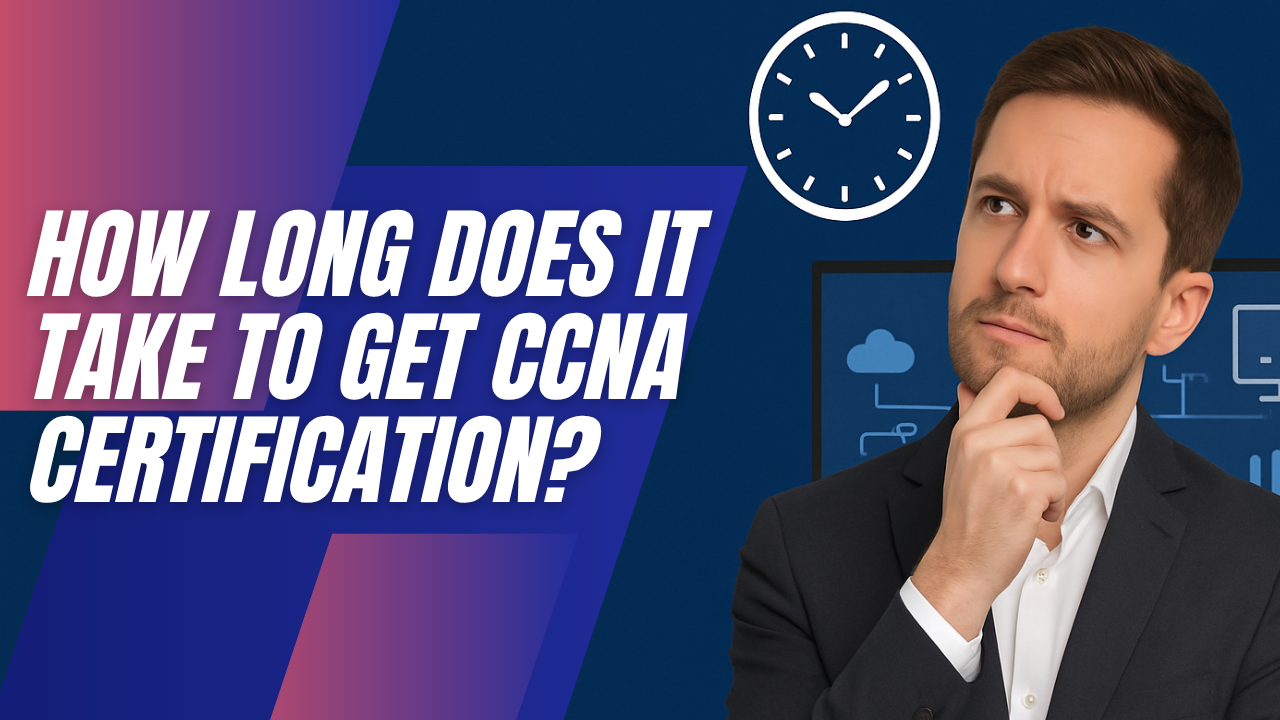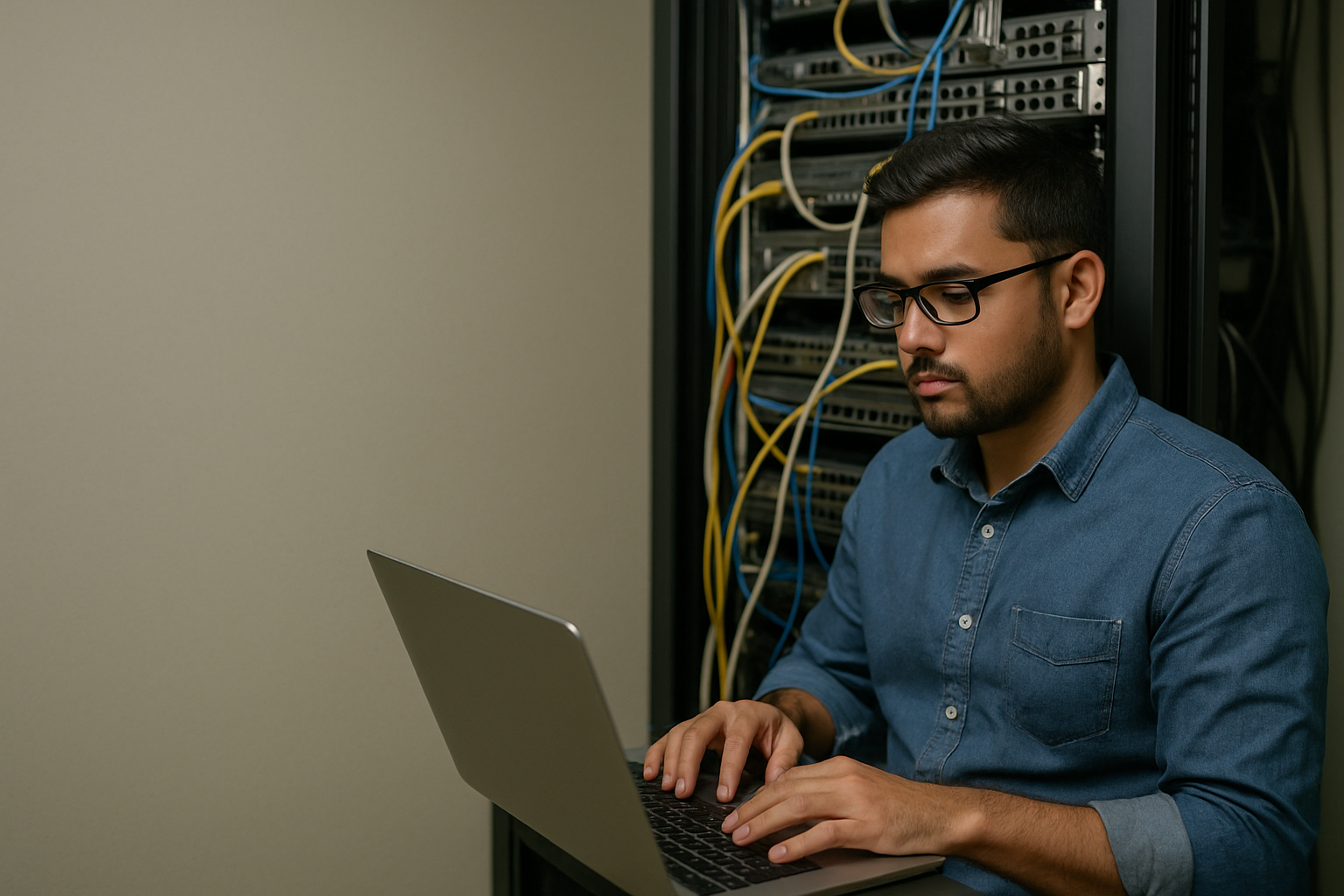How to Prepare for CCNA 200-301 Exam
Are you the person who is thinking about appearing for the CCNA 200-301 Exam, but don’t know where to start and when to start?
Do you need guidance to have a structured approach in preparing for your CCNA 200-301 Exam with your available study materials and succeed to be a Cisco professional?

The Cisco CCNA certification is a well-known choice for those who want a career in the networking field. Though the exam is challenging, you can clear it if you are ready to dedicate quality time to reading your study materials with focus.
To know how to use the right resources, you need both support and guidance at the right time. You must learn key networking concepts thoroughly and practise regularly to succeed in the first attempt.
While preparing for your CCNA certification, you will learn how to install, operate, and configure network components such as routers, switches, and wireless local area network (LAN) controllers, identify basic security threats and manage network devices.
You will also learn to verify an essential Ipv4 and Ipv6 network. In today’s competitive IT sector, this certification could make you an in-demand professional with lucrative perks and benefits.
Understanding the CCNA 200-301 Certification
If you want to choose your IT networking career as a network specialist, network engineer, cloud engineer or cybersecurity specialist, CCNA certification is a must. If you are a beginner or an intermediate-level networking professional, this certification helps you to stabilize and move up in your career. The certification is recognized at a global level that authenticates your skill in installing, configuring, and troubleshooting networks.
CCNA certification takes at least 3 to 6 months to be ready for the exam. It focuses on the networking skills necessary to install, build, operate, troubleshoot, and switch systems. The training improves an individual’s knowledge of network basics, network access, IP connection, IP services, security fundamentals, automation, and programmability.
You have to get a score between 810 and 850 out of 1000 points. The certification is valid for three years. You have to repeat the examination after three years to have a valid certification.
Having CCNA certification can get you the following job roles. Entry-level network engineer, Network administrator, Infrastructure Engineer, IT Specialist, Network specialist, Network support technician, Help desk technician, Network analyst, System engineer, and System administrator.
Topics covered in CCNA 200 – 301
The CCNA certification exam tests your knowledge of Network Fundamentals, Network Access, IP Connectivity, IP Services, Security Fundamentals and Automation and Programmability.
To have a better understanding of the CCNA exam, let us first know the question pattern that tests your knowledge. It is divided into six parts. The exam has 20% of the questions from Network fundamentals, 25% of the questions from IP connectivity, 20% of the questions from Network access, 10% of the questions from IP services, 15% of the questions from Security fundamentals, and 10% of the questions from Automation and Programmability.
Plan to spend at least three hours a day, so that you can complete a section in five days. Plan a schedule based on the weightage of questions in the exam.
Network Fundamentals (20%): In this topic, you will learn about different types of network components in detail that cover their functions and their roles in networking. It helps you to build the basic skills and knowledge needed to set up small or medium-sized networks.
Along with learning the networking basics such as the OSI model, subnetting, TCP/IP, and IP address, you will learn about LAN, WAN, VPN, IPv4 and IPv6 network concepts. You will also learn about topology designs of networks and different cabling types and physical devices.
Network Access (20%): In this topic, you will learn about the configuration and verification of VLAN, inter-switch connectivity, ether channel, layer 2 discovery protocols, Cisco wireless architecture, WLAN components, managing access connections of AP and WLC, and why spanning tree protocol and their operations are needed in a network. It helps you to learn about switching technologies, VLANs and wireless architecture in detail.
IP Connectivity (25%): In this topic, you will learn about routing fundamentals, OSPF and IP addressing protocols. You will also learn about routing table components, how a forwarding decision is initiated by the router, the configuration and verification of IPv4 and IPv6, and the configuration and verification of OSPFv2. You will also the purpose of the first-hop redundancy protocol.
IP Services (10%): In this topic, you will learn about the configuration and verification of NAT, NTP operating protocols, SNMP functions, the significant role of DHCP and DNS in a network, configuration and verification of DHCP client, how to configure network devices for remote access, how to use syslog features, and how FTP functions in the network.
Security Fundamentals (15%): In this topic, you will learn about firewall basics, network security principles, VPNs and intrusion prevention systems. You will also learn in detail about security program elements, security concepts, configuration of device access control, and security password policy elements. Remote access, configuration and verification of access control list, configuration of layer 2 security features, WLAN configuration, wireless security protocols and remote access protocols are also covered.
Automation and Programmability (10%): In this topic, you will learn about network automation techniques, basic Python scripting for network automation, and API protocols. You will also learn about the impact of automation on network management, JSON-encoded data overview, and controller-based networking protocols.
Who Should Take It?
The basic requirements for a candidate to take the CCNA exam are to have basic knowledge of computers, knowledge about IP addresses, internet usage skills, and navigation skills in computer operating systems. A candidate also needs a minimum of one year of experience utilizing Cisco products and their solutions.
The CCNA 200-301 is suitable for beginners who have an interest in networking, IT professionals who seek senior positions in network administration, students pursuing degrees in computer science, IT, or electronics, and anyone who aspires to become a network engineer, system administrator, or security specialist.
How to Prepare for the CCNA Exam – Step-by-Step
Step 1: Set a Realistic Study Timeline
Before you start studying for your CCNA exam, write down your study plan within a reasonable time frame that covers all the topics. At the end of your study sessions, review and recall what you have learnt. Your preparation time must be consistent with focus.
If you are a beginner with little or no networking experience, you may need to spend at least 10 to 12 hours per week from 4 to 6 months—spare extra time to be thorough with basic concepts of networking. If you are an experienced IT professional with some experience in networking, you may need to spend at least 6 to 8 hours per week for 1 to 3 months. Focus on updating your knowledge and practising.
Step 2: Choose the Right Learning Resources
You can excel in any technical certification with a clear understanding of the important concepts and theories of networking systems. Unless you are thorough with these concepts, you may not be able to troubleshoot and find the solution to the problem. As a first step, you must be thorough with the subject and excel in it.
Get expert guidance to choose relevant resources to prepare for the exam. Candidates who have good guidance and hands-on lab experience can clear their certification easily. Even if you want to do self-study, purchase quality study materials such as CCNA Certification Guides by Wendell Odom or Todd Lammle. They present comprehensive theories in an easy language.
Choose online resources like Cisco Learning Network to study as you go. In addition to your thorough reading of Cisco’s official study volumes, watching YouTube channels like JeremyIT-Lab may help to reinforce your knowledge of networking systems.
You can choose LINT’s Online course which has a smart combo of video, practice labs and mentor support. This platform offers a virtual lab for hands-on experience and it also guides you how to answer the MCQs with more clarity.
LINT offers a virtual lab environment to practice how to configure switches, routers and other networking devices. You can also use Cisco Packet Tracer, GNS3, Wireshark to simulate real-world networking scenarios to have excellent hands-on practice.
Step 3: How to Study for the CCNA Certification Exam Effectively
Before you start preparing for your CCNA certification, you must ensure you are strong in networking concepts and their systems. You must also know how devices communicate within networks and their roles in effective functioning.
Strategy A: Active Recall & Spaced Repetition
If you want to clear your certification on the first attempt, you need to follow two strategies. In addition to reading through the subject, it is important to recall what you have learnt. This will help you identify the areas where you need improvement and resolve them with expert help.
Spare time to resolve quizzes and exercises at the end of the chapters. Utilize available online exercises, quizzes, and simulations to identify and rectify mistakes. Make use of virtual labs offered by Cisco Packet Tracer to get hands-on practice and experience for simulations.
Strategy B: Follow a Learning Path
Initially run through the chapters for better understanding. It will be good if you plan your preparation in a well-structured schedule. Start reading about cabling, switching, and IP addressing in the chapters on Network Layers. Next read through chapters on Routing Protocols that cover OSPF, and NAT protocols. Finally, go through chapters on Network Automation and Security. Structured learning improves your chances of clearing CCNA certification on the first attempt.
Even if you have chosen self-study, enrolling in a training program can help you understand complex networking concepts. It can guide you on how to allocate quality time to study and practice simulations using virtual labs. The mock tests can help you to be prepared to answer any questions with confidence and clarity.
Step 4: Test Yourself with Simulated Exams
Mock tests help you prepare for your certification exam. It helps you to identify areas that need improvement and also know how far you have prepared for your exam. Take your mock test in a silent environment. Use a timer to keep track of your time.
Follow instructions as if you are taking the real exam. Taking mock tests helps to build confidence, manage anxiety, and improve your performance in the actual test. Practicing in virtual labs gets you hands-on experience in handling real networking issues.
A virtual lab environment will help you practice setting up routers and switches. By practicing you can improve your problem-solving abilities. While taking the practice tests aim for scoring 80% or more and repeat until you score. This will help you to score higher in your certification.
Step 5: What to Expect on Exam Day
You can expect from 100 to 120 questions that need to be answered within 120 minutes. You need to solve Multiple choice questions, drag-and-drop questions and simulations. They will test your theoretical knowledge and practical knowledge through performance-based simulations.
To manage time efficiently, spend reasonable time answering questions. Don’t feel anxious if you are presented with a tough simulation. If you have spent maximum time resolving a simulation during your mock tests, you will be able to resolve it quickly.
Hands-On Practice is Non-Negotiable
Without having regular practice using virtual labs, you may not be able to simulate real networking scenarios. Learn to use Cisco Packet Tracer or LINT’s built-in lab environment to resolve real-time networking issues.
Practicing in a virtual lab allows you to build networks without any real physical equipment. It helps to bridge the gap between theoretical knowledge and using networking systems in a real scenario. Unless you know how to configure protocols in a virtual lab environment, you may not be able to troubleshoot connectivity issues in real.
If you are ready to get started – Join LINT Today!
LINT offers a complete package for cracking CCNA 200-301 with in-depth lessons, real-world labs, personalized mentor support and practice tests to excel.
Join the LINT community and take your first step toward becoming a certified networking professional.
Conclusion
Earning your CCNA certification is a game-changer in your networking career. If you are a beginner or an experienced IT professional, CCNA certification can open options to get a better job position in networking, higher salaries and a fulfilling career in technology. Stay consistent in your preparation, and prepare smartly. You have to stay focused, use the right resources, and seek support when needed. With determination, you can land a successful networking career.
FAQ
There is no limit on attempts to take the CCNA exam. As you have to take the exam online, you have to wait for 15 calendar days between each attempt.
The exam fee for the Cisco CCNA is USD 300 (approximately Rs. 25,000 in India) plus applicable taxes. It includes registration fees, and proctoring fees, including taxes.
Cisco offers proctored online exams through Pearson VUE for many of its certifications including CCNA. The exam can be taken online from the office or home with a stable internet connection and a computer that meets its system requirements.
CCNA certification is a widely recognized entry-level certification that is valuable in India. It is a valuable credential for both freshers and experienced networking professionals. It is a stepping stone for advanced networking and cybersecurity roles.
The CCNA 200-301 has 100 to 120 questions. The exam duration is around 120 minutes. It includes multiple-choice questions, drag-and-drop, fill-in-the blank and simulations. The passing score is from 800 to 850 out of 1000, which is approximately 80% correct answers.





